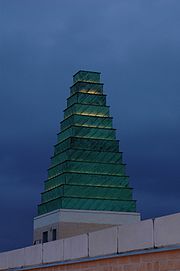
Copper cladding
Encyclopedia

- Seamed-claddingCladding (construction)Cladding is the application of one material over another to provide a skin or layer intended to control the infiltration of weather elements, or for aesthetic purposes....
(typically 0.7mm thick copper sheet on the facade): max 600mm by 4000mm 'seam centres'. - Shingle-cladding (typically made from 0.7mm thick copper sheet): max 600mm by 4000mm 'seam centres'.
- Slot-in panels (typically made from 1.0mm thick copper sheet): max 350mm wide for 1.0mm, by nominal 4 mtr length.
- Cassettes (typically made from 1.0mm up to 1.5mm thick copper sheet): largest-format cladding elements, more subframing is needed: can be 900mm x nominal 4000mm length.
When selecting size of a cladding element, take wind-loadings into account, and also consider the standard sizes available of the sheet (or coil) pre-material, to minimise material wastage through off-cuts. This helps to reduce costs.
The choice of which system to use depends on the aesthetic effect required, and building geometry
Geometry
Geometry arose as the field of knowledge dealing with spatial relationships. Geometry was one of the two fields of pre-modern mathematics, the other being the study of numbers ....
can also have an influence on the choice.
Copper cladding is very durable, lightweight compared to other materials and techniques, and at the end of the building life is also 100% recyclable.
Given the recent publicity about high metal prices, it may be surprising for most people to learn that copper is a very cost-effective cladding and roofing material. With good building design, materials choice and craftsmanship, copper roofing / facade cladding can be cheaper than slates
SLATES
SLATES is an initialism that describes the business impacting capabilities, derived from the effective use of Web 2.0 technologies in and across enterprises...
or concrete
Concrete
Concrete is a composite construction material, composed of cement and other cementitious materials such as fly ash and slag cement, aggregate , water and chemical admixtures.The word concrete comes from the Latin word...
tiles, especially when one takes into account the lasting colour, durability, maintenance
Maintenance, Repair and Operations
Maintenance, repair, and operations or maintenance, repair, and overhaul involves fixing any sort of mechanical or electrical device should it become out of order or broken...
-free and lightweight nature of the cladding.
Because the UK code of practice for "hard metal" cladding (as opposed to lead cladding)is quite old - CP143: part 12 (1970) - the major manufacturers have to provide detailed technical advice and information for architects, designers and builders, and cultivate skilled installers with years of experience to draw on.
The typical learning curve
Learning curve
A learning curve is a graphical representation of the changing rate of learning for a given activity or tool. Typically, the increase in retention of information is sharpest after the initial attempts, and then gradually evens out, meaning that less and less new information is retained after each...
for an installer of hard metal roofing and cladding is approximately 8–10 years before they can achieve a respectable experience on a work site.

